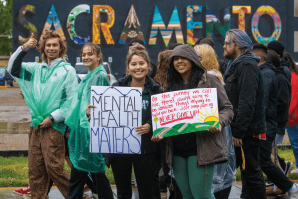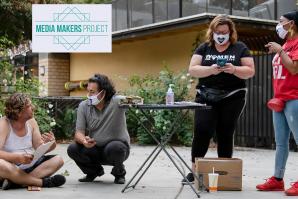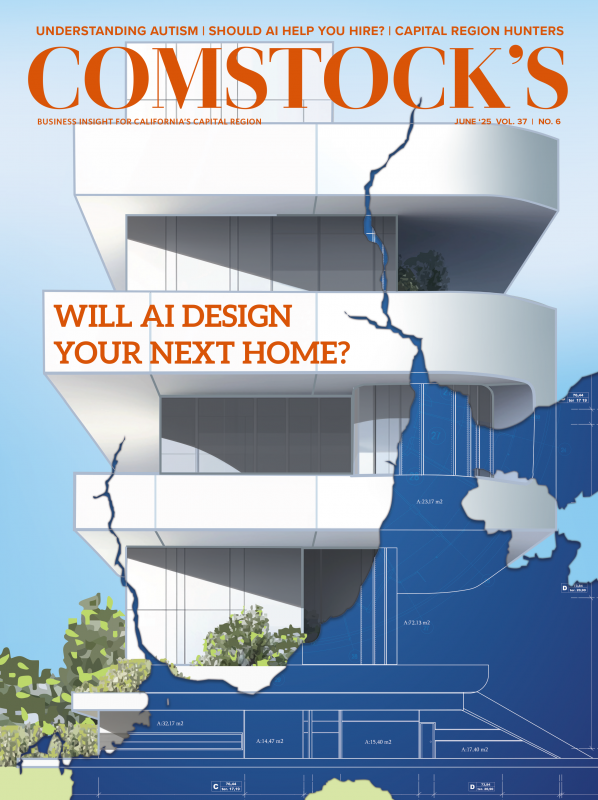Autism is neither a disease nor a sickness. But for the increasing population of those diagnosed — one in 31 children is the current count in the U.S., according to the Centers for Disease Control and Prevention — it’s quite real.
The developmental disorder encompasses a spectrum of manifestations but is too often viewed as a theory or used as a political football. And while most physicians, medical researchers and clinicians agree that those who have it are likely born with it, precisely what causes a parent to be its carrier is under study throughout the world.
What might surprise you is that when it comes to learning about and managing autism, the Capital Region is very much in the forefront.
For example, the MIND Institute at the UC Davis Medical Center in Sacramento has been studying autism since 1998 and currently evaluates around 6,000 children per year, a number that accounts for more than 10,000 clinical visits, to determine if they have it. There are no blood tests for autism, but a complex range of cognitive tests. As Aubyn Stahmer, a clinical psychologist who became executive director of the MIND Institute last year but has been with it for a decade, explains, the institute’s job is “to do evidence-based assessments of kids with neurodevelopmental disabilities.”
About 15 miles east in the village of Fair Oaks is Meristem, the leafy, 13-acre, skills-training campus for neurodiverse people from 18 to 28 years old. (Neurodivergent is a nonmedical term that describes people whose brains develop or work differently from most people, according to the Cleveland Clinic definition.) The students are here to learn skills ranging from woodworking to culinary arts and land stewardship so they can find meaningful jobs. An herbology class teaches students who may be adversely affected by the intensity of the flavor or the artificial ingredients in toothpaste how to make their own mint dental gel. Equally important, these young people learn to master essential life skills, develop a sense of self and improve their ability to engage socially.
Meanwhile, companies like PRIDE Industries, based in Roseville but with an outreach that encompasses 4,000 employees “coast to coast,” not only provides employee training and placement, but also educates potential employers about the benefits of hiring people with autism.
Types of autism
Autism isn’t very well understood because it can take many forms.
“We no longer use the term high- and low-functioning as they have very little meaning. I think you can say that the spectrum includes people with intellectual disability and limited communication as well as people with above average intelligence and verbal abilities,” Stahmer says.
“Another way to say it,” she says, “is that there are individuals who are profoundly affected in terms of physical or intellectual disabilities, and there are individuals whose autistic traits may be more subtle.
“The current terms we use include the range of individuals on the autism spectrum. The severity ratings are related to how much support a person needs in areas of communication and daily living.”
While one in 31 children in the U.S. are now diagnosed with autism, “that number was only one in 750 kids” in 1995, when the son of Lou Vismara, the retired cardiologist who helped found and initially fund the MIND Institute with developer Angelo Tsakopoulos 27 years ago, was first diagnosed, he says.
That’s a staggering increase. So what happened? Are we experiencing a lengthy epidemic whose numbers have grown quietly but exponentially in just 30 years — or, as many suspect, have we just begun to scratch the surface of a condition that’s been with us for quite a while, lying either dormant, undiagnosed or misdiagnosed?
“There is not a definitive answer,” Stahmer says. “Likely, much of the increase is due to changes in the diagnostic criteria. The DSM-5 definitions since 2013 (which stands for Diagnostic and Statistical Manual of Mental Disorders, Fifth Edition) are more broad, and more children are included. Awareness has increased, so more children are being identified, including children from historically marginalized groups who were missed or misdiagnosed in the past.
“We no longer use the term high- and low-functioning as they have very little meaning. I think you can say that the spectrum includes people with intellectual disability and limited communication as well as people with above average intelligence and verbal abilities.”
— Aubyn Stahmer executive director, MIND Institute
“This is more of a re-categorization in some cases,” she adds. “There may be other factors as well, such as prenatal exposure to things like rubella, environmental toxins and so forth. But certainly, increased awareness and identification of more adults and people with less functional impairment is a primary reason.”
Donna Courville, a partner in Sacramento’s Boutin Jones law firm and board chair of Meristem, says she knew her son Alex, now 23 and working in a trades job at Southwest Airlines, was “developing differently” than his big sister Samantha when he was a toddler. “But at the time, pediatricians often assumed that if a little boy was acting rambunctiously but a little girl wasn’t, it was just a case of boys will be boys,” she says one recent afternoon over an alfresco lunch in the cafe at Meristem’s campus — a meal largely prepared by campus students.
“We just offered the chef a job with us,” says Erin Schirm, Meristem’s executive director for the past three years, whose seven years with the institution included several years as a teacher. “He’ll live on campus in his own apartment, earn a salary and feel like somebody. That’s what we do,” he adds.
PRIDE Industries’ Vice President for Workforce Inclusion Darelyn Pazdel says her principal job and passion is to educate employers about why they should hire people with disabilities, including autism. Two thousand PRIDE employees have some sort of disability,” she says. “But we’ve managed to find jobs or directly hire people to work in electronics, information technology, accounting and data analytics, among other fields.”
Meristem in Fair Oaks helps young neurodiverse people ages 18-28
years old learn skills for adulthood. Executive Director Erin
Shirm, left, with Emma Smith, a member of their welcoming
committee who hands out her drawings to visitors.

She adds that her job has been a continual learning experience. “I used to be a complete linear thinker. But working with people who were born with challenges has made me realize that almost everything is possible for people willing to try, especially if they have the support of friends or loved ones.”
Pazdel isn’t alone in her mission to make the world take a more benevolent, if pragmatic, look at autism.
Five years ago, MIND Institute co-founder Vismara co-wrote a book called “The Autism Full Employment Act,” subtitled, “The Next Stage of Jobs for Adults with Autism, ADHD, and Other Learning and Mental Health Deficiencies.” The title is a clever if hopeful misnomer. There is no “act” — at least, not yet.
The book, a collaboration between Vismara and Michael Bernick, both of whom are adjunct professors at Stanford University and have grown children with autism, offers several initiatives to make the act a reality, including a discussion about how companies can develop autism-friendly workplaces.
Bernick’s son William, now 36, and Mark, Vismara’s son, have different levels of autism. Vismara says, “Mark works two days a week at a warehouse where he sorts and packages donations. He also restocks some vending machines twice a week. In addition, he has a dog walking service and volunteers at a church where he stocks the sanctuary once a week.”
The language of autism
Autism has its own preferred language. In most cases, it’s more appropriate to say that those experiencing it are people with the condition, not that the condition unalterably and indelibly defines them.
“Sometimes I say someone’s an autistic person and at other times I say this is a person with autism, depending on the sensitivity of whom I’m talking to,” says Stahmer of the MIND Institute.
Stahmer says most people refer to autism as a condition experienced by people “whose brains work differently. We feel pretty confident that whatever causes it, it occurs before birth. But the condition can present itself differently.” She says that to explain autism in a single, anecdotal catchphrase does a disservice to the patient. “To put it succinctly,” she says, “if you’ve met one autistic person, you’ve still met one autistic person.”
Myths about autism, Stahmer says, include that “all the people who have it have no feelings, that they can’t look directly at you, that they’re incapable of speech. Those things certainly occur but not in all cases.” She also says that the ratio of males to females who have the condition is now calculated at four to one (although there is a rise in female autism), and that there can be a higher incidence among siblings and with identical twins.
Among the conditions being studied by the MIND Institute and its vast network of contributing physicians, psychologists and researchers — “from around the country but also right here in town, where we work with Sacramento State and Kaiser Hospital” — are attention-deficit/hyperactivity disorder, Down syndrome and fragile X syndrome, which can cause delays in learning to talk, as well as hyperactivity and in some cases, seizures.
The research on autism is ongoing. Sixty members from different departments at the MIND Institute are working together toward common goals.
“Research at the MIND Institute involves neurodevelopmental conditions. We have researchers who focus on basic science, interventional genomics, neuroimaging, behavior-based interventions, education, employment for people with developmental disabilities and much more,” says director Stahmer.
“For example, the Autism Phenome Project is one of the largest long-term studies of its kind in the world. It includes autistic and non-autistic individuals, including many with intellectual disability, which is unusual. There is an accompanying study, GAIN (Girls with Autism Imaging of Neurodevelopment), which is focused on females with autism. The goal of these studies is to identify autism subtypes. The Autism Phenome Project started in 2006 and follows participants over many years, looking at behavioral and neuro-psychological assessment, blood draws, medical history and an MRI scan of the brain,” she says.
Autism testing involves procedures such as gathering early eye-tracking movement data and cognitive exercises. Most children are diagnosed at about 18 months of age.
Theories abound about what causes autism, from the disorder running in families to a parent being of an advanced age, from an expectant mom’s exposure to air pollution or pesticides to maternal obesity and birth injuries such as oxygen deprivation. There is also a frequently debunked (by physicians and scientists) but nevertheless persistent suspicion that vaccines bear responsibility for many cases of autism. It’s a subject currently under further study by a task force chaired by U.S. Secretary of Health and Human Services Robert F. Kennedy, Jr., which is scheduled to present its findings in September.
Autism in culture
Like many medical conditions, autism has picked up unwanted steam on social media. As soon as we encounter people who don’t fit into our prejudices, it’s easy to say they’re “on the spectrum.” The very classification can sound like a dismissal, even if the person who has it also displays genius-level skills.
That idea was given glamorous credibility in the film “The Accountant” and its just-released sequel, in which Ben Affleck plays a seemingly emotion-free numbers cruncher with autism who also happens to have brilliant survival chops. And in Barry Levinson’s 1988 movie “Rain Man,” in which Dustin Hoffman won an Oscar for his performance as an autistic savant.
“The more we see people with autism as functioning, even productive members of society, the more awareness there’ll be,” says Meristem’s Schirm. During a visit to the campus, a guest is shown through studios, classrooms and a magnificent garden, maintained by the students. A student with autism, Emma Smith, presents the guest with a drawing she’s done for him of a purple heart with a crown and the word “Kings” hand-printed within its perimeter.
About half of the 52 students live on campus at Meristem, which was named in honor of a plant tissue that lets flowers and others grow taller and healthier. The organization has 70 employees and an operating budget of $6 million, much of which derives from grants and donations and some from tuition costs. Those range from $33,000 (it goes up to $35,000 next year) for day students and $103,000 per year for live-in students. “Most of our students’ tuition is covered by regional funding programs,” Schirm says.
The continued exploration and understanding of autism prompts people, especially the parents of children who have it, to wonder if a cure is in the works.
“It’s not an illness, so we really can’t talk about there being a cure,” says MIND Institute’s Stahmer. “It’s a neurodevelopmental condition. It’s not something a child will grow out of.” While medications can often help reduce the severity or anxiety of a patient, treatment and therapy are key words. Acceptance — of the condition and the people who have it — is the other term we’re hearing more and more.
“A lot of people who have autism learn to live with it as a kind of chronic condition,” Stahmer says. “It’s the people around them who sometimes find it more difficult to handle.”
–
Stay up to date on business in the Capital Region: Subscribe to the Comstock’s newsletter today.
Recommended For You

A Push for School-Based Mental Health
Ratcheted up by the pandemic, students’ mental health has become an important focus in schools
Schools and universities in the Capital Region have taken an array of approaches to assure mental health is one of the many pillars a student’s education addresses.

Speaking Up About Autism
Opinion: Dr. Lorerky Ramirez-Moya shares her experience as the mother of an autistic teen
To mark World Autism Month, Dr. Lorerky Ramirez-Moya of MindPath Health in Roseville offers a guest contribution reflecting on her experience as the mother of a teenage autistic son.

Placer County Superintendent of Schools on Issues Facing The Public School System
Hitting the books: Placer County Office of Education’s Gayle Garbolino-Mojica on the county’s public school system.

Creating an Impact
Meet some of Sacramento’s advocates working to help others in the community
Comstock’s spoke with five people on the frontlines of making positive change in Sacramento.




